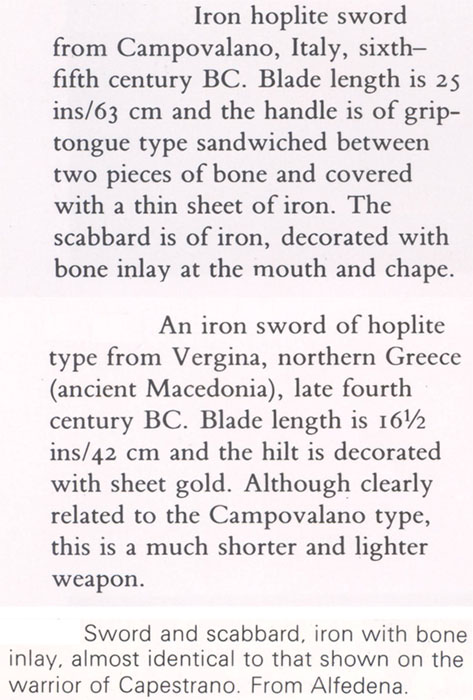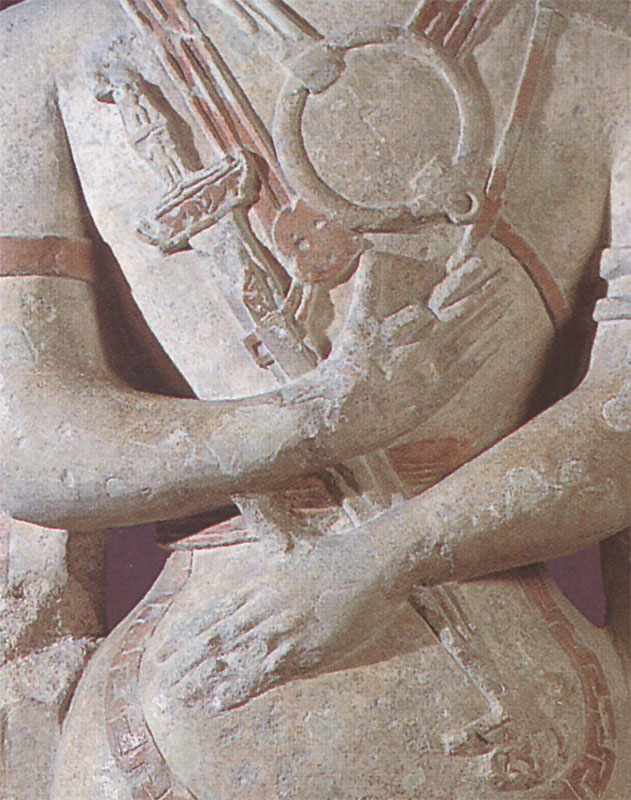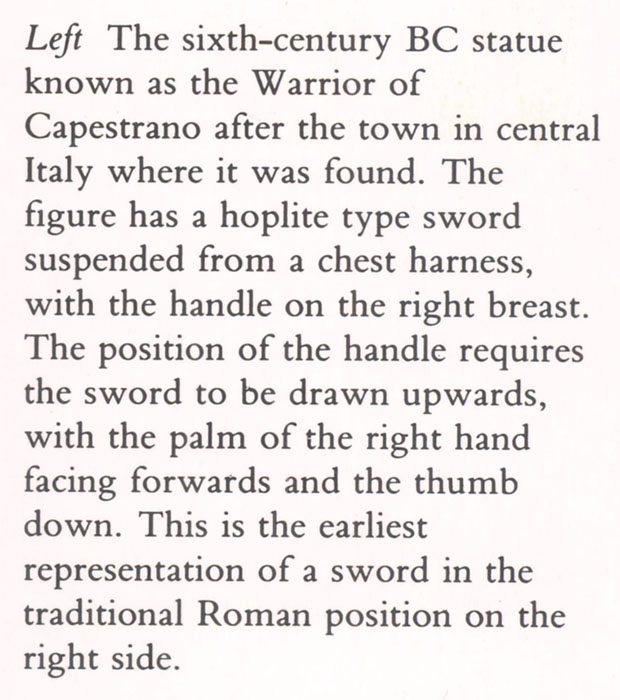Unfortunately there is very little information on the net about them.
Here is what I've managed to find using the net and the books I have.
Please also find attached some pics from the following books:
Sword and Hilt Weapons
Greece and Rome at War
If anyone has any further information or pictures (photos) of these Xiphoi please post.
Thanks
Danny
##############################################################################################
1) Campovalano Xiphos
Xiphos from the necropolis of Campovalano di Campli, Abruzzo region Italy.
6th-5th century BC
(Museo Archeologico Nazionale, Chieti, Italy)
Overall Length: ?
Blade Length: 25 ins/63 cm
Weight: ?
From "Sword and Hilt Weapons" by Peter Connolly
"Iron Hoplite sword from Campovalano, Italy, sixth-fifth century BC. Blade length is 25 ins/63 cm and the handle is of grip-tongue type sandwiched between two pieces of bone and covered with a thin sheet or iron. The scabbard is of iron, decorated with bone inlay at the mouth and chape.
Pictures (Bottom of the page):
http://www.apunis.it/storia-piceni.asp?lang=eng
http://www.apunis.it/gallery/storia-piceni-foto4.jpg
http://www.sanniti.info/smweap01.html
Campovalano and Alfedena Xiphoi
http://www.penn.museum/documents/publications...farani.pdf
##############################################################################################
2) Veria/Vergina/Veroia Xiphos
Xiphos from the necropolis of Veria/Vergina/Veroia, Macedonia.
370-350 BC
(Archaeological Museum of Veroia Macedonia)
Overall Length: 60 cm
Blade Length: 16 1/2 ins/42 cm
Weight: ?
From "Sword and Hilt Weapons" by Peter Connolly
"An iron sword of hoplite type from Vergina, northern Greece (ancient Macedonia), late fourth century BC. Blade length is 16 1/2 ins/42 cm and the hilt is decorated with sheet gold. Although clearly related to the Campovalano type, this is a much shorter and lighter weapon."
From odysseus.culture.gr website:
http://odysseus.culture.gr/h/4/eh430.jsp?obj_id=4734
"This well-preserved sword comes from a cist grave in Beroia. The long, leaf-shaped blade is made of hammered iron. It had an ivory pommel and a cylindrical handle that widens in the middle. The handle is decorated with two embossed gold leaf figures of Nike, each holding a shield and sword, and standing on Ionic columns. This particular type of sword with its long blade and flattened cylindrical handle was most commonly used between the 6th century BC and the late Hellenistic period. This example was made in a Macedonian workshop. The same grave also produced a bronze hydria containing the bones of the deceased and many other interesting funerary gifts."
Exhibit Features
Date: Hellenistic period, End of the 4th - beginning of the 3rd century BC
Place of discovery: Veroia, Classical - early hellenistic necropolis of Veroia
Dimensions: length: 0,60 m
Material: Gold, Ivory
Exhibition hole: Hall A
Copyright: HEllenic Ministry of Culture
Pictures:
http://www.macedonian-heritage.gr/HellenicMac...1273c.html
##############################################################################################
3) Alfedena Xiphos
Xiphos from the necropolis of Alfedena, Abruzzo region Italy.
6th century BC
(Museo Civico Aufidenate "A De Nino" Italy)
Overall Length: ?
Blade Length: ?
Weight: ?
From "Greece and Rome at War" by Peter Connolly
"Sword and scabbard, iron and bone inlay, almost identical to that shown on the warrior of Caprestrano. From Alfedena."
"Suspended from the harness of his cuirass on the right side, the Caprestrano warrior has an elaborately decorated sword. An almost identical sword was found at Alfedena. This was only one of a large number of iron swords and scabbards that have been found. These swords are all of Greek hoplite type probably adopted from the Etruscans. Their blade lengths vary between 60 to 70cm. The handles and the top and bottom of the scabbards of these swords are made of bone covered with iron. This iron facing often has pierced decoration so that the bone shows through."
Pictures (Bottom of the page):
http://www.roma-victrix.com/armamentarium/pvg...ntiqui.htm
http://www.sanniti.info/smweap01.html
Campovalano and Alfedena Xiphoi
http://www.penn.museum/documents/publications...farani.pdf
##############################################################################################



[ Download ]
[ Download ]